I recently got a call from a guy I know to the west of Wanganui, a hill country farmer with a good sized sheep and beef farm bordering the Wanganui National Park. I met this farmer on one of my backblock road trips a few years ago, at the time he was developing this farm from a rundown condition. When I first met him, he invited me to help hammer the goats pouring out of the bush. That first visit was full on goat mayhem. Went through 300 rounds between four rifles; .223 Rem, .243 Win, 6.5 Creedmoor and .308 Win. I saw fallow deer but was so accustomed to not shooting them (fallow are currency on most of the other places I visit), that I just shot the goats.
Despite being only 43km from my normal area, as the crow flies, there are no red deer here at all. Red deer seem to stop at the Wanganui River, give or take, any further west and it must be a swimmer. (To give you a clue about the regional topography, it might only be 43km as the crow flies, but the most direct route by road is about four hours drive.)
The owner has put a hell of effort into this farm, I couldnít believe the difference. Heís got a high electric wire around his top flats boundary fence, where heís set up an excellent system of lambing paddocks. Thereís much better access, new implement sheds, tractors and fertiliser bin at the well graded airstrip, the works. Itís now one of the best fenced farms youíll ever visit. So I can drive the Hilux up the perfect metalled access race onto the plateau at the top of the hill. If you could see the hill, you would instantly recognise why this is such a good thing.
Lambing has just started properly, and everything is set up perfectly with the best pasture for the triplets and twins ewes. The singles are a ways out but theyíve got plenty of tucker. Grass is in very short supply this year due to the earlier drought this past summer. Hence the pressure on pests. This paddock has just been finished by ewes about to drop their lambs. The bush blocks in the background are teeming with fallow deer.
To this second visit then. It was a frosty start in the morning, a real finger biter. All the cold weather gear came out Ė itís the little things that count, like decent gloves, a small scarf. Nothing worse than being cold and not being able to use your fingers.
Thereís hardly a goat to be seen compared to last time, such is the huge eradication effort thatís gone into this block. The emphasis this trip was on the fallow, which have expanded greatly in numbers. All varieties of coloration are present, even a couple of white ones. The cockie reported that there was a mob of mostly young animals, all melanistic variety, that were coming out in the same place every day, so that was the place to go look.
I shot just three measly goats during the first hour of light on the way into the back paddocks on the plateau. One was however a solid longer range effort for a 6mm, and my personal 6mm record to date. On the first morning of my first trip, in the exact same location, I would have shot upwards of 30 I expect, they were everywhere. The rest of the morning was spent in reconnaissance mode and watching fallow as they retreated to the bush to bed down and ruminate. It was time very well spent, as I could see pretty much straightaway where the fallow were entering the bush.
After heading back to the house for an early lunch and a nap, it was all about getting in position a good hour before deer oíclock, which felt like it should be around 4 p.m. After a minor track mishap that involved me needing the winch rope, I made it around to the back of the farm hard up against the bush, where I thought I had a good chance of accessing the hunting grounds without being winded. From the end of the race at the boundary fence, to the fantastic shooting positions in between rocky knobs overlooking the last rough paddock, itís about 1.5km of up and down undulating pasture. Itís an impossible bush edge to fence, as the papa rock outcrops in high rubbly faces which shed large blocks which roll down and destroy fencing. So the last paddock isnít fenced on the perimeter, but rather some 200-300m in and beyond rolling boulders. This long unfenced perimeter paddock of quite rough feed runs right round the plateau flats, and is mostly used for older Angus cows that know their way around. So all up, conditions are perfect for a daily invasion by pest ungulates.
Everything in the surrounding bush is geared around this pasture access. The tracks in the native bush, leading to this corner from three points of the compass, are worn like a network of dairy races. Thereís bugger all feed under the canopy and itís easy to move around in there. Very noisy walking though, as thereís so much dry sticks and leaves. The point at which the tracks all converge and exit into the pasture on the edge of the bluffs is like the entrance to a supermarket - the deer and goats have to come out because thereís no food left in the forest. The point at which they go in and out of the bush is about 500m from the highest rocky knobs.
This kind of shooting is pest control. Whilst the country is dramatic and steep, itís not ďproperĒ hunting. It is all about the numbers, and to get permission you need to demonstrate you arenít in the business of making pests gun shy. There are three aspects this farmer took time to come and check last time round, by turning up unexpectedly and observing me shooting goats. Firstly can I shoot at all, secondly can I shoot the way this kind of country demands, and thirdly do I know my way round a farm.
This guy has put a lot of money into this farm, and he cannot allow the game / pests to eat out the rougher pasture that the cattle and unproductive sheep can keep in good order. If he is to have sufficient feed to carry unproductive stock through late winter and spring, he needs pest animals to be killed in numbers. The focus is on the pest does & nannies and their young. This means controlling your urges - leaving the nice buck off on his own, and instead going for the group of juveniles and does. And you must put the deer down. Runners are not encouraged. Minimising the number of mature does that escape is the goal, so shoot them first, then the youngsters will 99% of the time run a short way, then stop to look back.
One real challenge is the damn Paradise Ducks. What a bloody pain in the arse. They live up there in numbers like Iíve never seen before, and it was a constant bother to keep running into them and sending them up to circle and honk.
There is no access to the back block other than on foot across the stretch of pasture below the scarp. This run of rough pasture is hidden from the hunting ground by the aforementioned rocky knobs, which means any deer out already canít see you approaching. But you have to get out early else there will likely be deer on the scarp bush line above you, and theyíll look right down at you and raise the alarm. The wind is a killer, because you are looking east with the dominant westerly at your back, no other way round it. The way the deer select an area to habitually return to day in, day out, is simple but effective Ė sun, grass, a clear and wide field of view, wind almost always blowing from the direction that danger usually arrives. Once the deer have made it to the flatter pasture on the other side of the shooting position, there is no way to stalk in really close to them. By close I mean anything less than 300m. It would be like trying to stalk a deer standing on a golf green by walking down the middle of the fairway, with the wind behind you. Waving a big flag. Coo-eee!
So thatís the kind of range you need to work with: 500 at the first line of rocky outcrops, down to 300m at the second line. I decided to reduce the range as far as possible as I had the 6mm and not the 6.5mm, so 108gr vs 143gr. I made it unobserved to the second outcrop and set up on a tiny grassed point with tussock around me for a degree of cover. It really helps to have a bright, low sun at your back, as the deer will have a hard time looking into the sun.
The deer popped out of the bush bang on time, no more than 5 minutes after I setup, which was a lucky break and all part of the learning of a particular area. Need to get their earlier next time, I thought. It was also obvious how the older animals stood and winded hard in all directions, right at the crest of the clear cut on the edge of the native. The younger ones were far less cautious. I watched one buck winding and looking nervous, before turning and bolting back into cover, and I thought oh here we go, they've winded me and now they're off. But no, the rest didnít pick up anything they didnít like. Range was 295 - 315m across the mob, so 1.1 - 1.2 MRAD up and weíre good to go. As mentioned, largest doe first, then whatever I can get.
I shot the largest doe, but the others scattered too fast for a second shot. After waiting a couple of minutes, I decided to move to a position with a different field of view on to the far bush edge, and take a chance on the deer coming back out again as the sun hit the horizon. So I quickly scrambled down to GPS mark the position of the doe in case it was dark by the time I returned, and took off back to the next shooting position. Rewards came about half an hour later right on sunset, as out stepped a group of four fallow deer, a prickett, one doe and two yearlings, all of whom dropped to the shot at between 270-300m.
An unfortunate billy goat was too slow retreating to the bush edge, as he didnít seem that sure where the shots were coming from due to the sharp reflection and echo of the report. He changed direction twice and dithered. Bonus goat.
All the eveningís action was setup by the recce earlier in the day. Thereís no substitute for a bit of observation before setting foot in the hunting area.
This kind of shooting is why I tend to favour a Varmint rifle. Shot strings of 5, 6, 7 or more shots is not unusual. My .308 sporter contour rifle is well hot after a string like that, and wanders slightly high and left. But my Varmint rifles just stay nice and cool and steady as. I use a Harris bipod with spikes and podlock, and jam the feet into the turf for a dead steady rest. Sometimes for the long stuff I use a rear bag, but it wasnít necessary today. The hold on the deer with this setup is rock solid.
Now I had just enough light to deal to five beautiful eating deer. Inspection of the carcasses showed perfect bullet performance. Aiming for hilar shots, the bullets all exited bar one, which I recovered. This recovered bullet had a diameter of 0.836Ē, which goes to show how well these ELD-M expand into spinning, weight shedding cutting machines.
Exit holes were a good size and blood flowed freely, not that any tracking was necessary as they all fell over there and then. These being quite small fallow, I was glad I hadnít brought the 6.5mm and kind of annoyed I hadnít brought the .223 Rem. At 300m, a 55gr hunting bullet would be the mustard on these small deer. Why anyone in their right mind would even think to suggest that a 6mm is not enough gun for a deer this size Ė like many of the Europeans Ė is beyond me.
I took the backstraps and rumps off the deer as it got dark, and resolved to do a second run. I trudged off back to the truck with a heavy pack and my ridiculous but deadly 13lb rifle. It was quite a mission in the dark, nothing quite like the sound of a spooked herd of Angus charging around in the dark when you canít see them. Back at the truck I had a refreshing motivational beer, packed the meat into the Engel and took off back to the carcasses. I whipped out the guts, took the hearts, loin fillets and kidneys, and hacked off the remaining rear leg and neck meat for dog tucker. I managed to avoid cutting myself, and the pack was a lot lighter for the second return to the truck. An easy drive out and I was done for the night. Happy to get cleaned up, get the meat into the fridge and drink some more brown ale.
When I wrote this it was well before dawn on the following morning, which came with a hard frost and fog. There are more magpies in this valley than the whole of the Waikato in total, so I rested my legs and lured unsuspecting noisy annoying Australian birds to their fate. I took it very easy until early afternoon, then headed of again to the same spot for some more action. Part 2 to follow.
Welcome guest, is this your first visit? Create Account now to join.
Welcome to the NZ Hunting and Shooting Forums.
Search Forums
User Tag List
+ Reply to Thread
Results 1 to 15 of 53
Thread: Fallow and the 6mm Creedmoor
-
28-08-2020, 12:40 PM #1
Fallow and the 6mm Creedmoor
Just...say...the...word
-
-
28-08-2020, 12:54 PM #2
The previous day’s activities taught me a lot, so the following day I arrived in the same spot at the fence to take stock of the wind. I was earlier this time, and I was a bit frustrated as on the drive over the hill past the tractor shed, I’d already glassed far out towards the bush and could see deer everywhere. Far out they must be hungry, feeding out in the open in the early afternoon. This meant a wholesale change to tactics.
The wind was fickle, blowing this way and that, gusting quite strongly. That meant that just one gust contrary to the dominant flow could wreck the hunt. I decided I would be either seen and / or winded if I took the same approach as the day before; this time I would walk in through the boggy lowland between the ridges, using the topography as cover. The risk of doing this was that the higgledy-piggledy nature of the terrain meant the wind could be funneled in just about any direction, which proved to be the case!
On my way down into the bog, I glassed ahead and spotted a mob of does and yearlings resting in a small paddock next to an old shed down in the bottom of the valley. This was totally unexpected, and potentially quite lucrative, so I double checked my route and made it to a ridge overlooking the shed from 250m. I had another higher ridge behind me hiding me from the fallow I was originally targeting – they wouldn’t have been too far away. Decisions decisions. I decided to have a shot at a doe near the shed and see what happened next.
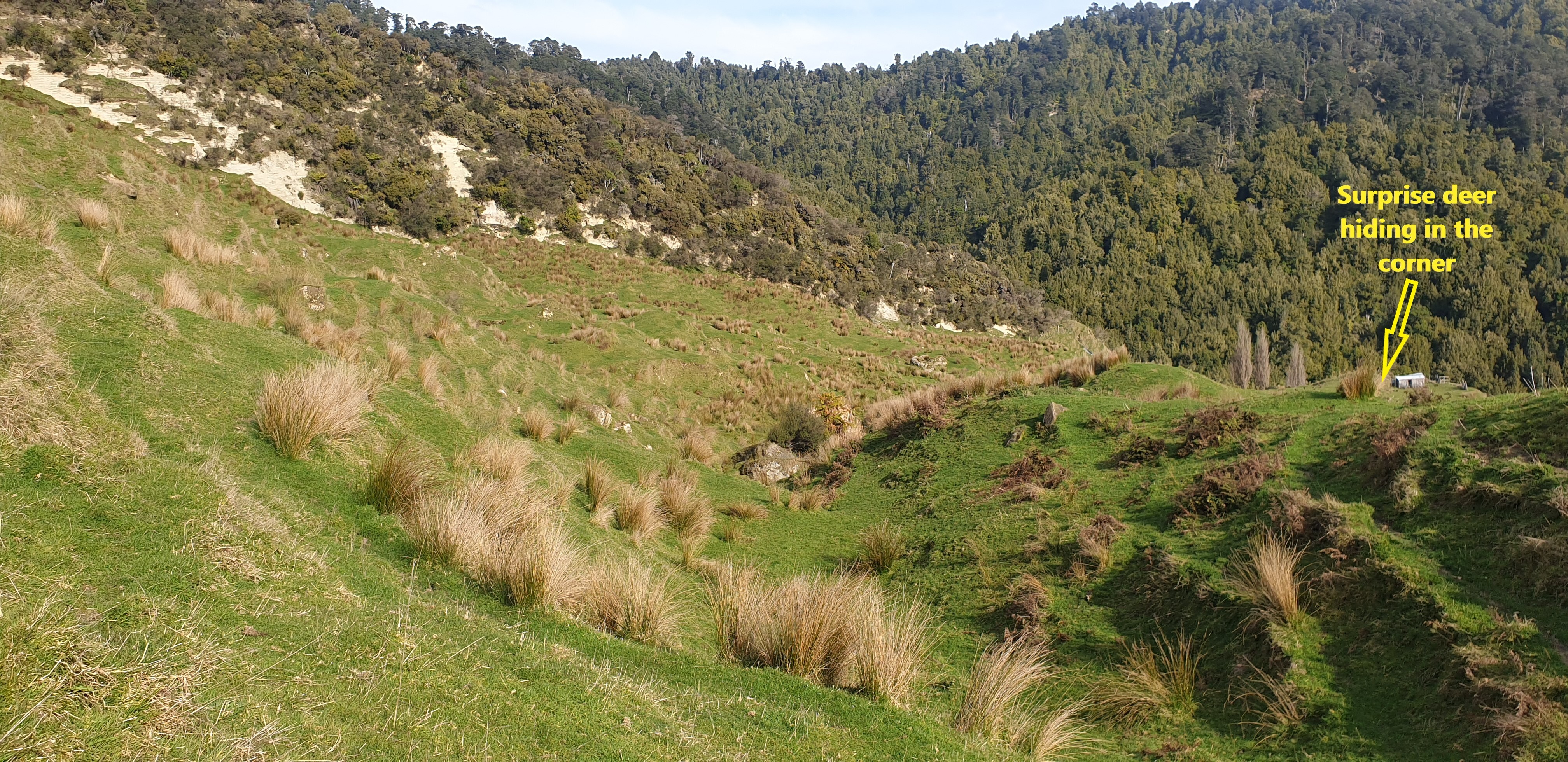
Up until this point on this trip, I hadn’t bothered filming the shots. But after the success of the previous day I’d thought hmmm, a video of a couple of fallow commencing their journey from bush paddock to my plate would be good. So I cautiously set up the camera and the rifle, got ready but not in a particularly systematic kind of a way, steadied myself, and took the shot...
This is one of the reasons I like hunting on my own; when I screw it up, there’s no audience to feel embarrassed in front of and make excuses to, and it’s easier to try and find the root cause for the miss. First things first… make the rifle safe, then settle in to watch my new video of me missing. I had clearly shot just over the top of the spine, as the splash behind the animal was obvious and I could see the divot with the binoculars.
Now for me to have missed by that much at that range, something quite serious must have gone wrong. Point of aim was the midline of the torso for the hilar shot – with the steep downhill angle of the shot and the bullet’s trajectory that should put me bang on the money. It did the day before…
I knew there was nothing wrong with the ammunition, so quick check of the scope mounts, double check I’d remembered to screw the suppressor on, adjustable check rest was good, parallax was set correctly… oh bugger and shite there was nothing more to it, I’d simply screwed it up.
When you drop a shot like this to poor technique, it’s really annoying. I did a dry run to try and repeat how I’d set up, which if you could see the hummocky ground on the ridge would probably be quite funny. I realised that the line of my body was angling away from the line of sight, with my midriff draped over the break in slope, my hips dangling with both legs scrabbling for a grip, whilst my right elbow was in an odd place relative to the rifle. Everything was wrong I had been in a rush, I was really worried about the wind and that ultimately was my downfall. Rushing. I’ve done this before and the poor body position has a massive effect on the point of impact.
Oh well. Time to take a harden-up pill and get over it. I had time on my side, and even though I knew the other mob of fallow would be gone, there was still plenty of time for them to come out again. I turned back to the ridge behind me and scrambled up. With no sentinel eyes on me (that I knew of) I took the time to find a spot on the ridge that afforded me a degree of cover from tussock, plus a straight body and line of sight, with good foot support. Once set up, with a bullet in the chamber and the bolt ready to cock, I settled in for some patient glassing. After 45 minutes or so, a really nice old buck came out further up the ridge, but after some hard winding, he turned and buggered off. He didn’t like the atmosphere at all. Another quarter of an hour later and two young bucks, a doe and a yearling came out in the exact same place as they had the day before. The bucks were chasing the doe which was strange to see but at least their pursuit of poontang meant they were less interested in self-preservation.
At 370m I gave them a chance to settle down and starting browsing – once they had their heads down they slowly ambled down the face getting closer and closer. I really wanted the doe and the yearling, but they disappeared into a hollow and I could only see the two bucks. At exactly 300m they both found some feed worth stopping for, and that was the last thing one of them ever did.
At the shot, the other three deer bolted – the doe straight back into cover, the yearling stuck to the other buck and ran towards and across me. They made for a track taking them up into cover, but as is so often the way, right at the last second they stopped for a quick look back for their mate. There was no time to waste, I’d already dialled back to zero as they ran (good habit that), now I acquired the second buck in the sight picture and guesstimated the range at a couple of hundred-ish. Slight hold over, bang, flop. It was all over in a flash. The yearling simply vanished.
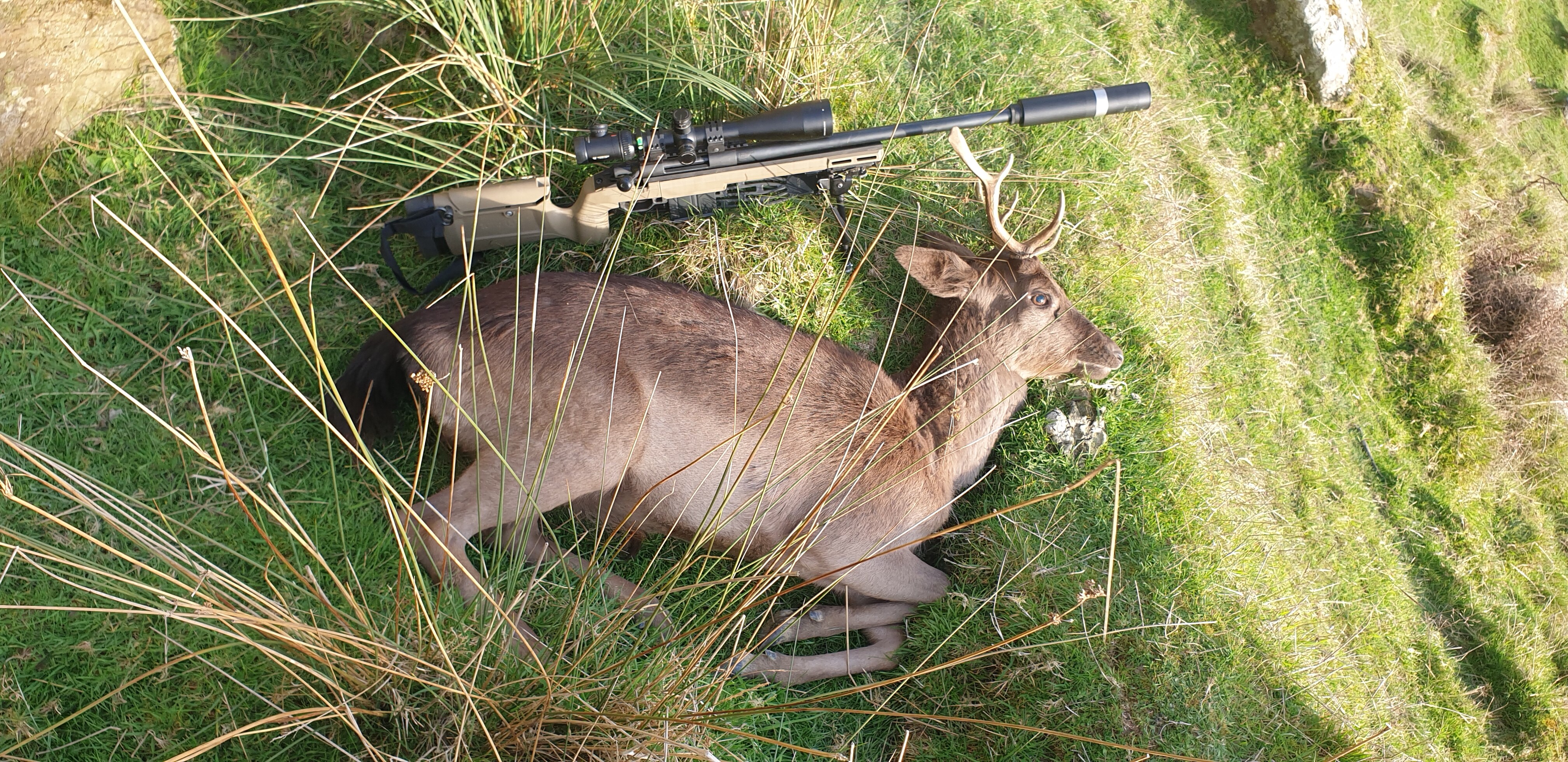
That was pretty gratifying. I packed up and worked my way up to the second closer buck, checked him out and took a couple of pictures. A rising 2-yr from the antler development. He was smaller than the fallow over our way, but fat as which was good to see. I moved him to a better position then went and found his mate. Same age, just as fat. I dragged him down to the other one and set about cutting them up.
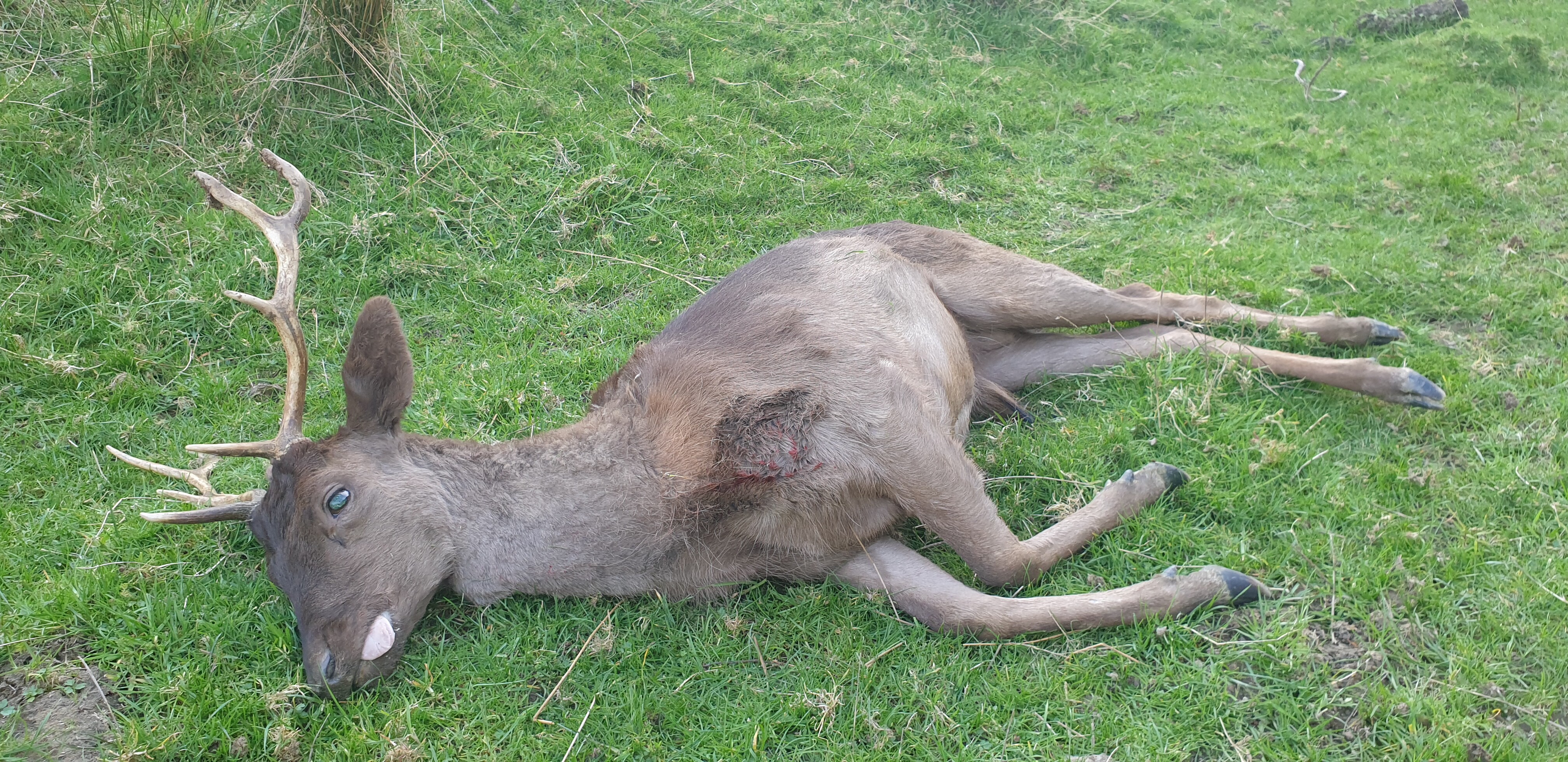
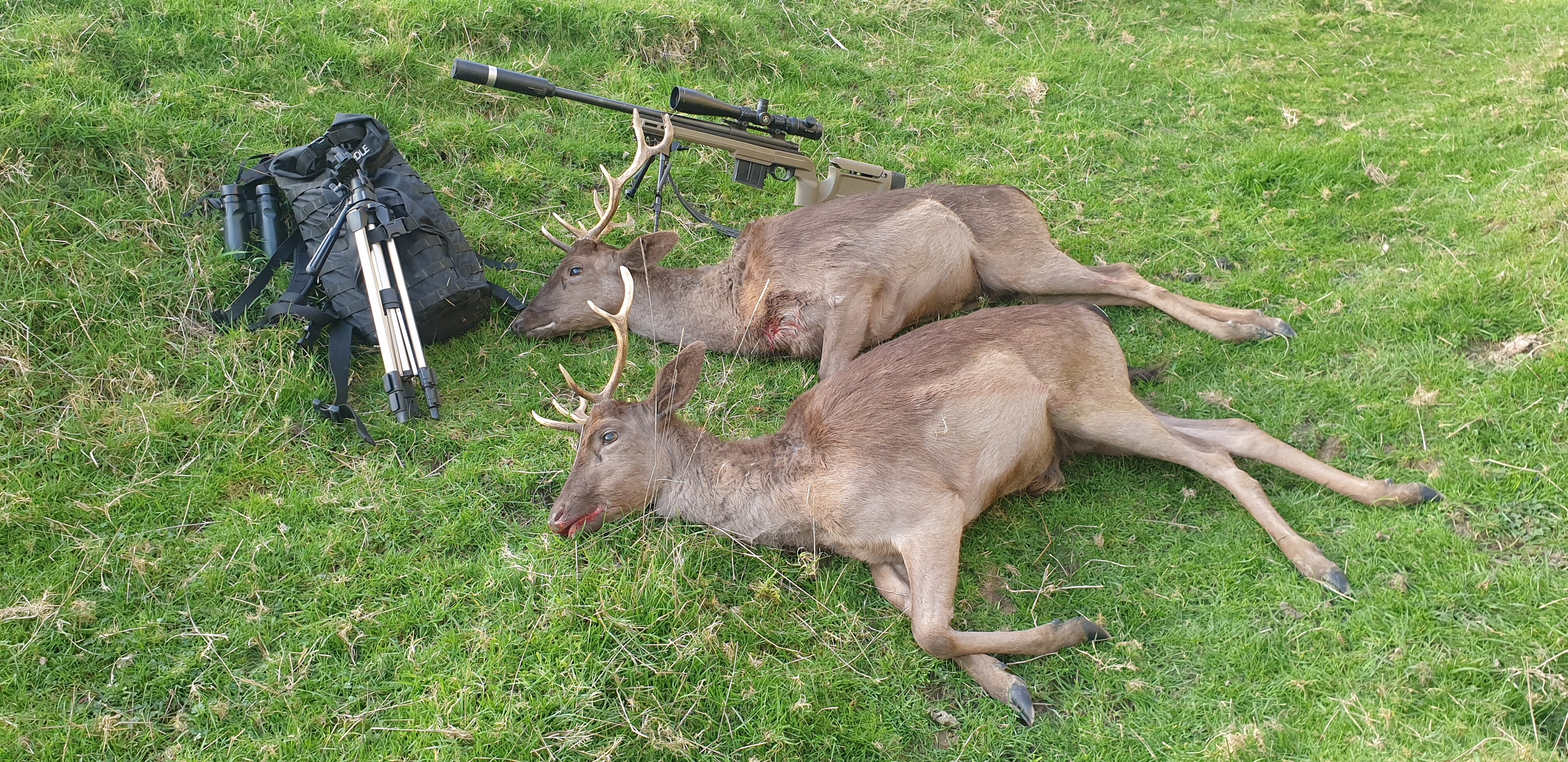
Neither 108gr ELD-M had exited, hardly surprising as both shots were strongly quartering towards and in through the chest. This shot placement destroys the lungs and top of the heart and 9/10 will drop instantly like these two. But it is also likely to puncture the rumen, which it did in both cases. I’m not worried about that as I don’t need to recover the whole deer, a quick check and it’s yup, messy, so plan B which is leave the guts in and bone it out after skinning the animal from the spine down.
A good haul of meat from these two animals as the shoulders were untouched. The pack was well heavy as I turned to hike back to the truck. It was just starting to get dark, so the timing was perfect. A satisfying all over tiredness came over me when I got back to the house, all I could manage was a beer and a slice of toast, then into bed. The weather was changing, it was warm as, the high “mackerel sky” clouds at dusk had hinted strongly at coming rain. And rain it did, from about 3 a.m. onwards, sheets and sheets of unseasonably warm rain. So that was that, time to go home via just one more quick farm visit in the northern Taranaki to try and shoot a problem boar…
And the final step before the story is complete...

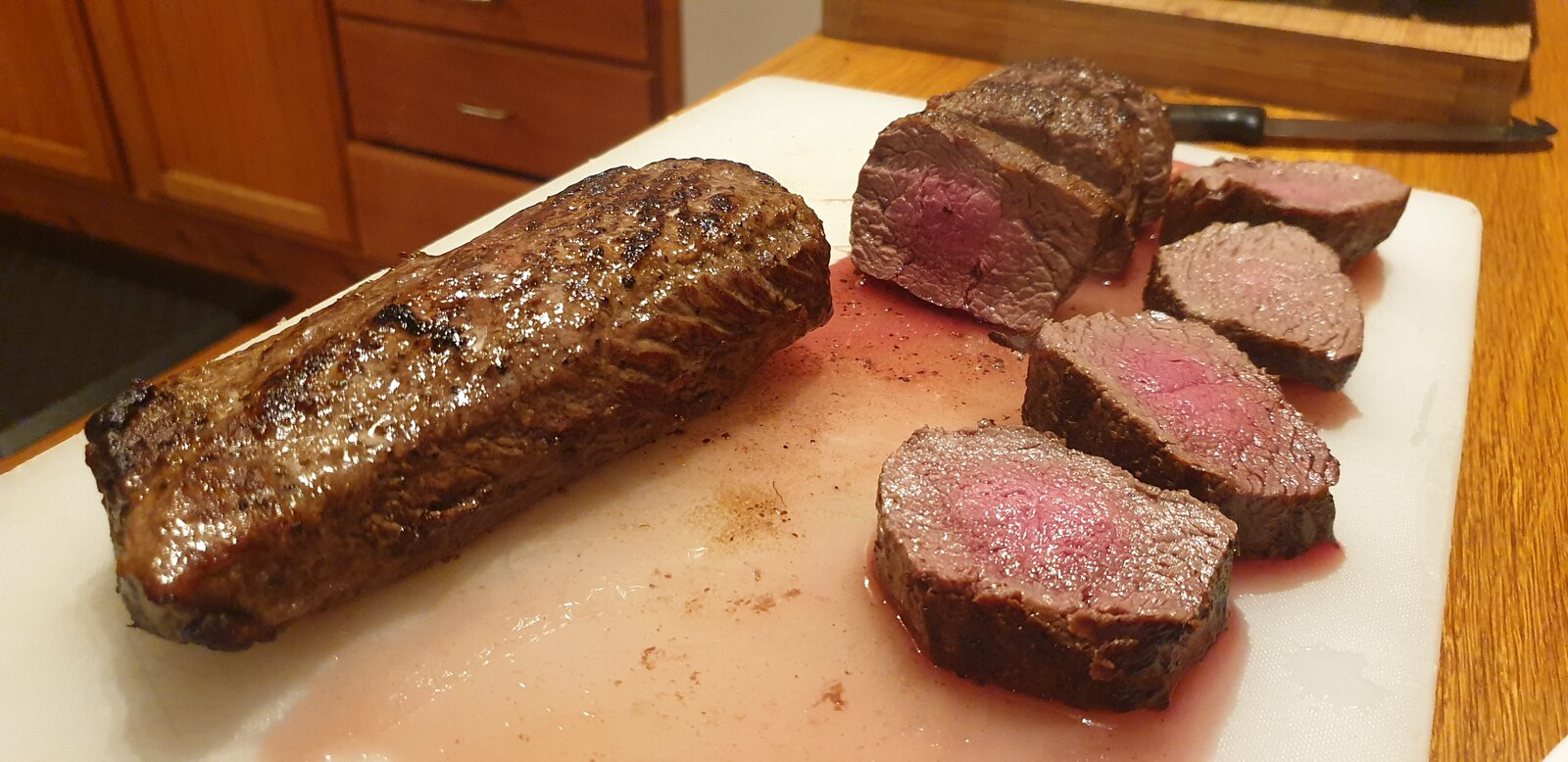 Just...say...the...word
Just...say...the...word
-
28-08-2020, 01:16 PM #3
Thanks for sharing, you know how to write a good story.
-
28-08-2020, 01:23 PM #4Member

- Join Date
- Jan 2020
- Location
- Waikato
- Posts
- 293
Nice write up - awesome to have access to land like that!
-
28-08-2020, 01:46 PM #5Member

- Join Date
- Aug 2018
- Location
- Taranaki
- Posts
- 448
Enjoyed that write up bro, awesome work smashing them out.
-
28-08-2020, 01:53 PM #6
Thanks fellas.
Please excuse the upside deer. No amount of effort will encourage the forum software to turn it round...Just...say...the...word
-
28-08-2020, 02:48 PM #7
Great read. Reckon this sort of thing really helps with learning
-
28-08-2020, 03:22 PM #8Link

- Join Date
- Jan 2013
- Location
- Canterbury
- Posts
- 211
Nice write up, cheers mate
-
28-08-2020, 03:44 PM #9Member

- Join Date
- Aug 2015
- Location
- West Auckland
- Posts
- 1,132
Amazing story, great country, great shooting, thanks for sharing. Only in Aotearoa do we get the freedom and ability to do what you did.
-
28-08-2020, 04:28 PM #10
Great story mate, took my mind off a stressful Friday at work. That shot over the top was so close , thanks again.
-
28-08-2020, 06:08 PM #11
great yarn & good advice on wee mistakes that can be made in shot set up that lead to a miss and WTF moment.
Plenty of yummy back steaks there.
-
28-08-2020, 08:22 PM #12Member

- Join Date
- Jul 2014
- Location
- BOP
- Posts
- 4,074
You sure can write a good story, well done, nice shooting and a pile of tasty looking venison. That 6mm is a nice size for those deer.
-
28-08-2020, 08:26 PM #13Member

- Join Date
- Jul 2020
- Location
- Waikato
- Posts
- 558
Yeh, ditto on the write up, and photos, sure looks cold and short of grass. I don't miss, but I do fire warning shots now and again.
-
28-08-2020, 08:57 PM #14Gone but not forgotten

- Join Date
- Apr 2017
- Location
- Hamilton
- Posts
- 4,129
I have been impressed, and a bit shocked, at the terminal performance of the little 6mm pills on fallow deer.
I tried to post a couple of photos but the site won't let me.
-
28-08-2020, 09:03 PM #15
Shocked @Cigar?
Just...say...the...word
Similar Threads
-
Fallow or red?
By matto1234 in forum HuntingReplies: 12Last Post: 27-05-2019, 11:05 PM -
1st blood for the creedmoor and 1st fallow for me and the hornady edlm smashed em
By rambo-6mmrem in forum HuntingReplies: 14Last Post: 16-04-2019, 02:02 PM -
222 vs Fallow
By viper in forum Firearms, Optics and AccessoriesReplies: 71Last Post: 28-08-2018, 10:51 PM -
An Odd Fallow
By Tahr in forum The MagazineReplies: 10Last Post: 09-02-2018, 09:52 AM -
My first fallow...
By Matt-j in forum HuntingReplies: 7Last Post: 25-11-2016, 06:42 AM
Tags for this Thread
Welcome to NZ Hunting and Shooting Forums! We see you're new here, or arn't logged in. Create an account, and Login for full access including our FREE BUY and SELL section Register NOW!!





 90Likes
90Likes LinkBack URL
LinkBack URL About LinkBacks
About LinkBacks
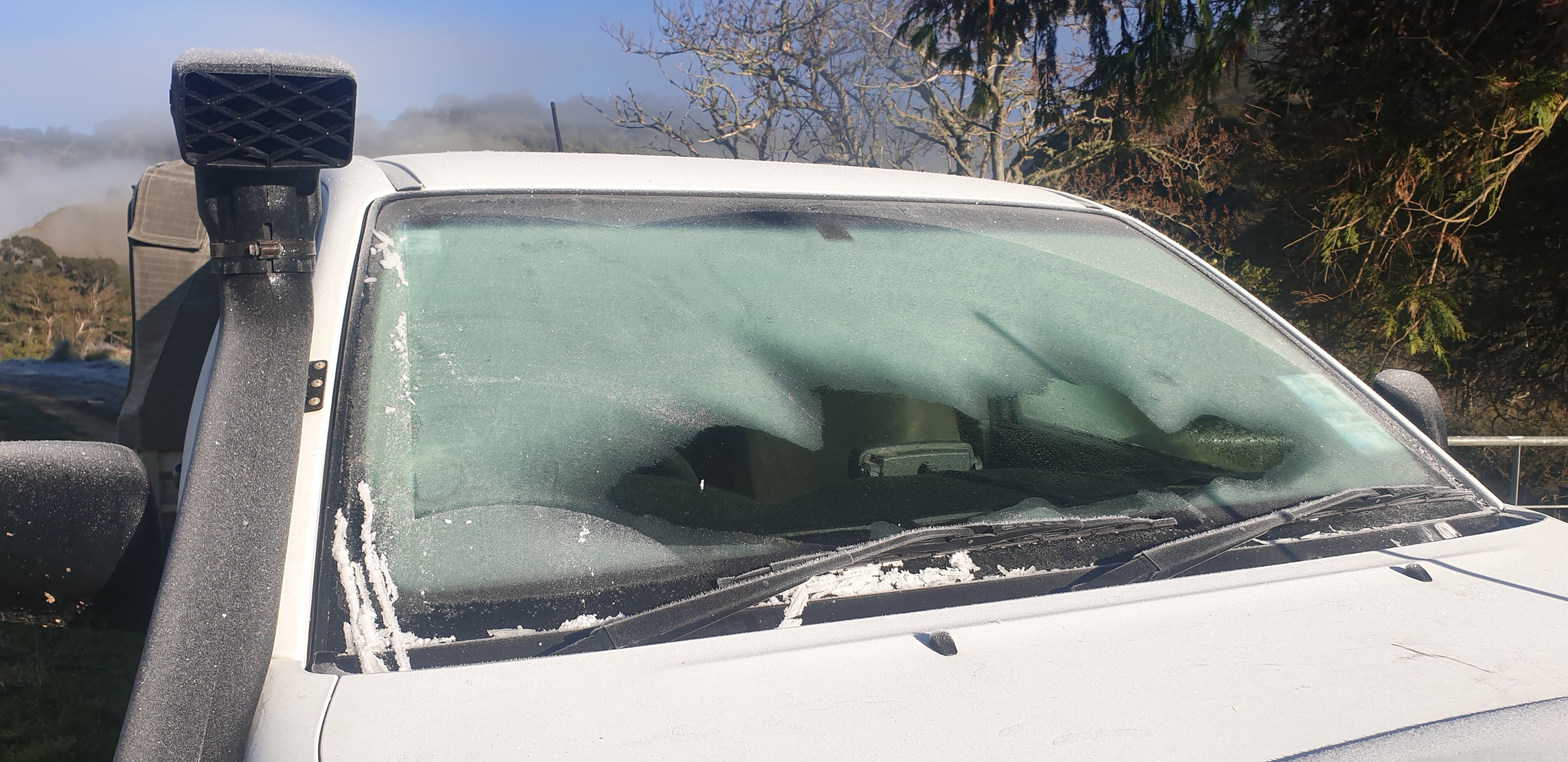

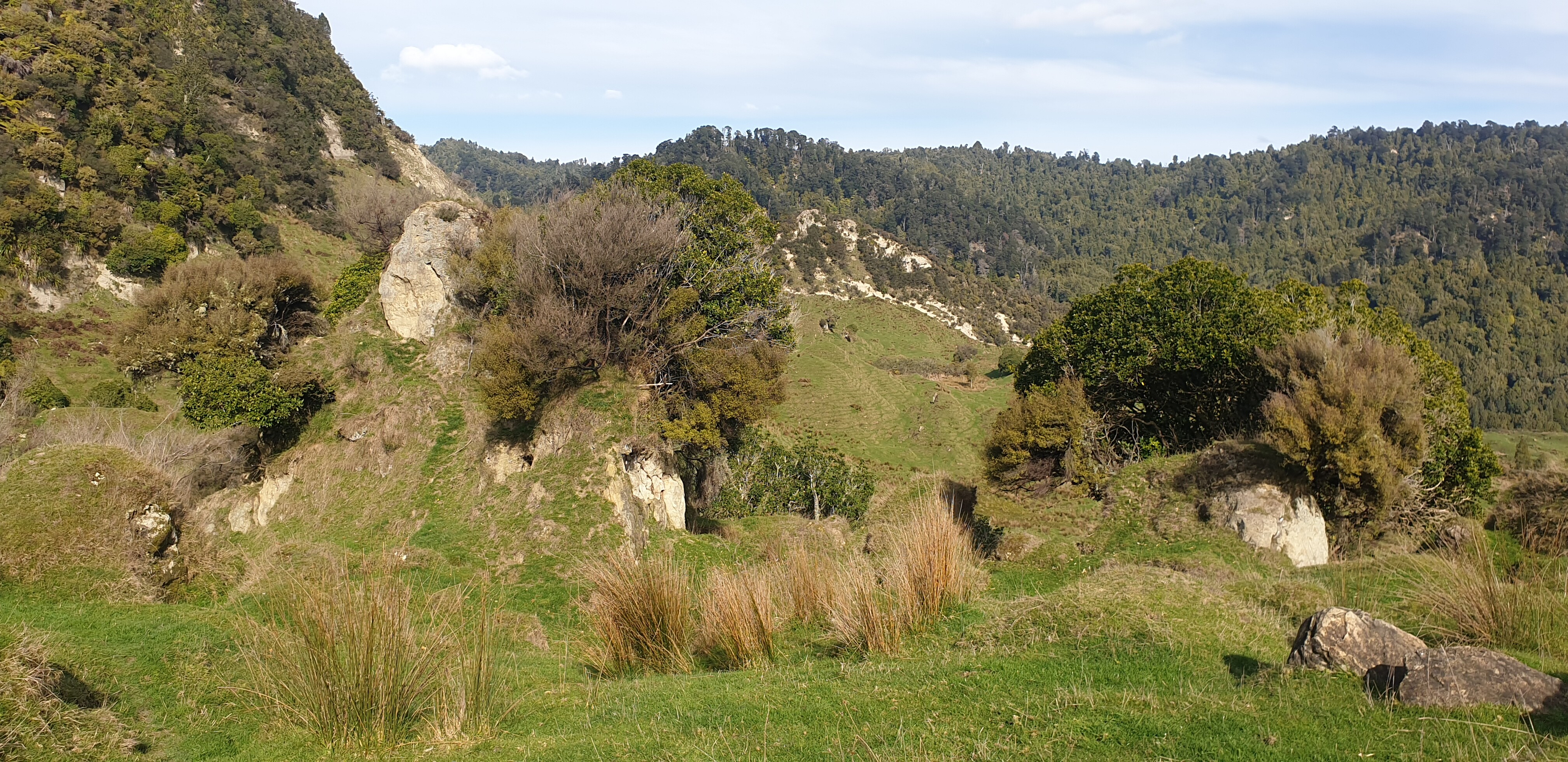

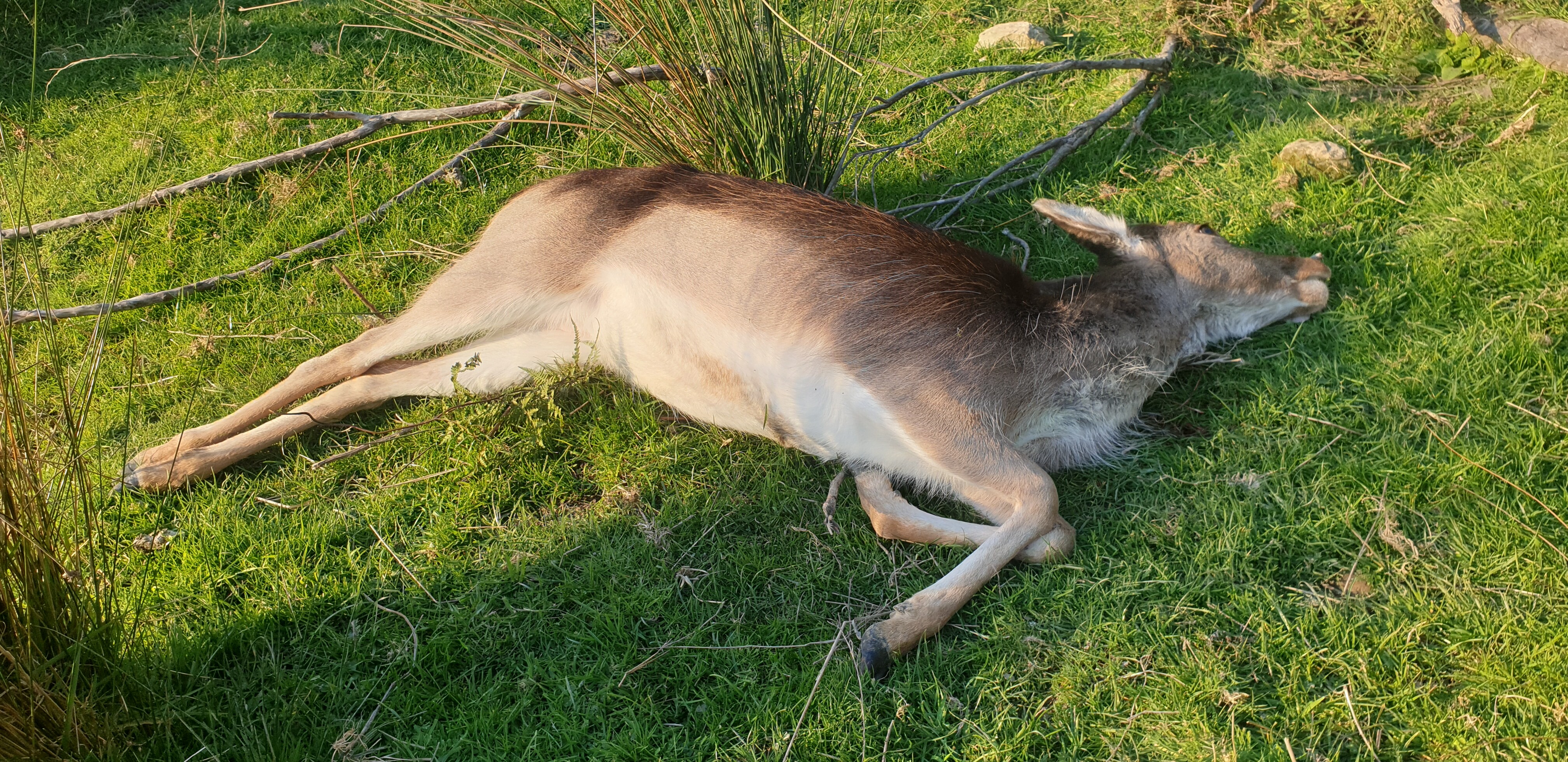

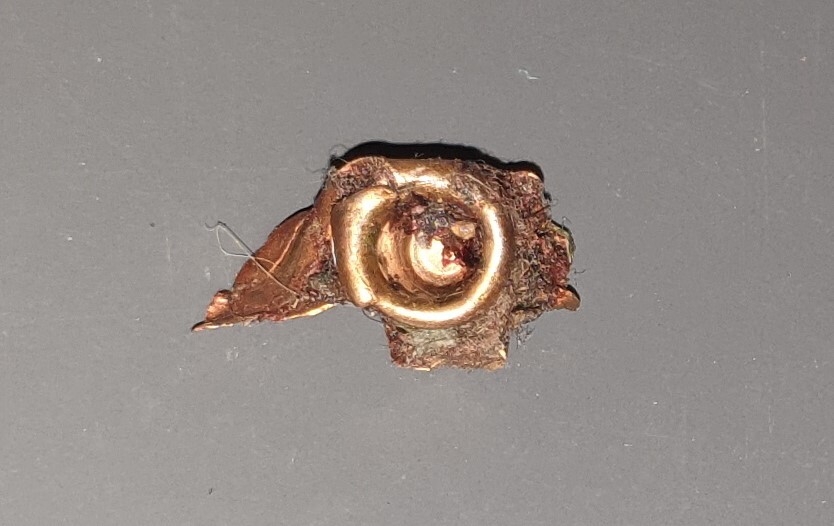






 Reply With Quote
Reply With Quote


Bookmarks